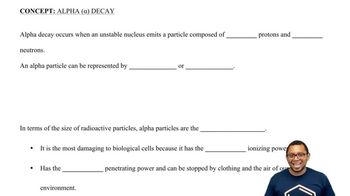Here are the essential concepts you must grasp in order to answer the question correctly.
Nuclear Decay
Nuclear decay is the process by which an unstable atomic nucleus loses energy by emitting radiation. This can occur in various forms, including alpha decay, beta decay, and gamma decay. In the case of Polonium-210, it undergoes alpha decay, where it emits an alpha particle (helium nucleus) and transforms into a different element, lead-206.
Recommended video:
Balanced Nuclear Equation
A balanced nuclear equation represents the transformation of one element into another during a nuclear reaction, ensuring that the total number of protons and neutrons is conserved. In these equations, the atomic numbers and mass numbers of the reactants and products must balance. For Polonium-210 decaying into Lead-206, the equation must reflect the emission of an alpha particle to maintain this balance.
Recommended video:
Balancing Chemical Equations (Simplified) Concept 1
Alpha Particle
An alpha particle is a type of radiation consisting of two protons and two neutrons, essentially a helium nucleus. It is emitted during alpha decay, a common form of radioactive decay for heavy elements. The emission of an alpha particle reduces the atomic number of the original element, leading to the formation of a new element, as seen in the decay of Polonium-210 to Lead-206.
Recommended video:
 Verified step by step guidance
Verified step by step guidance Verified Solution
Verified Solution



 4:23m
4:23m